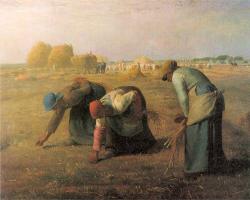![]()
![]()
Millet's The Gleaners and the History of Gleaning
Millet's The Gleaners is probably the best-known painting of gleaning. Many have seen the painting, but few know much of the history of gleaning nor of changes to the right to glean that are the background to the painting.
Jean-François Millet |
Old Testament In the Old Testament, the widow Ruth the Gleaner humbled herself by gleaning in the fields of a wealthy farmer named Boaz. Boaz was attracted to Ruth and married her, and later Ruth gave birth to a son, Obed. Through Obed, Boaz and Ruth became the great grandparents of King David of Judah and Israel. Early Europe Possibly because of its Biblical references, gleaning, and the leaving of materials for gleaning, became an accepted part of European rural life throughout the Middle Ages, and the right of usufruct was established. This was the right to use and enjoy another's property on the understanding that this use would be without destroying, damaging or diminishing the property. 19th Century Europe In nineteenth century France and other countries, usufruct rights, including the right to glean, were reduced or withdrawn, provoking resistance among peasants, as depicted in Balzac's novel of 1845, Les Paysans (The Peasants). This unrest is the background to Millet's painting The Gleaners. |
More History
See the brief history of gleaning on Wikipedia.
For more on the history of broader meanings of gleaning, see this excerpt from "Resource Gleaning, From Earlier Times to the Information Age" by
William Bostock (Download [![]() 235KB]):
235KB]):
Related Topics
Gleaning and Charity
Both the Bible and the Koran discourage waste and encourage charity at harvest time.
Some verses bear directly on gleaning and the responsibility of farmers to make it
possible for the poor and hungry to glean.
more ...
Gathering vs Gleaning
Gleaning is a response to potential waste, usually in the context of scarcity for some. That means that gleaning only becomes a possibility with cultivated crops (agriculture) and a chance of surpluses, some of which might go to waste.
Gathering (as in hunting and gathering) may be a response to scarcity, but it generally implies a collection from
wild plants.
more ... (preliminary)
Agricultural Waste
Waste is a fact of life in agriculture, even for small, organic farmers. In
general, there is more waste in annual crops than in perennial vine and tree crops.
This is probably because annual crops can respond to changing markets, which
encourages speculation in planting and marketing.
Waste occurs on the farm, in stores, and at home. Recent studies estimate that
40 percent or more of all cultivated food is never eaten.
more ...
![]()

![]()

![]()

Partially Funded by the California Council for the Humanities, UC Santa Cruz, and INTA - TrainingWeal.

